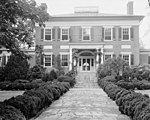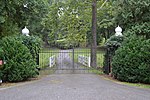Casa Maria

Casa Maria is a historic estate located near Greenwood, Albemarle County, Virginia, United States. The main house was built 1921–1922 in the Spanish-Mediterranean style, with a two-story brick addition that dates from 1928, and was designed by architect William Lawrence Bottomley. The main house consists of two perpendicular, 2+1⁄2-story, stucco wings with a low-pitched hipped roof and low roof hidden by a parapet. It features an enclosed garden with stuccoed walls, arched entrances, and brick paving is located in the angle of the two wings. Also on the property are two Spanish style stuccoed servant's quarters with decorative metal grilles and tile roofs, and several smaller outbuildings. The gardens were designed by noted landscape architect Charles Gillette.The estate was added to the National Register of Historic Places in 1990.
Excerpt from the Wikipedia article Casa Maria (License: CC BY-SA 3.0, Authors, Images).Casa Maria
Backwoods Lane,
Geographical coordinates (GPS) Address Nearby Places Show on map
Geographical coordinates (GPS)
| Latitude | Longitude |
|---|---|
| N 38.031666666667 ° | E -78.753611111111 ° |
Address
Backwoods Lane 7310
22943
Virginia, United States
Open on Google Maps










